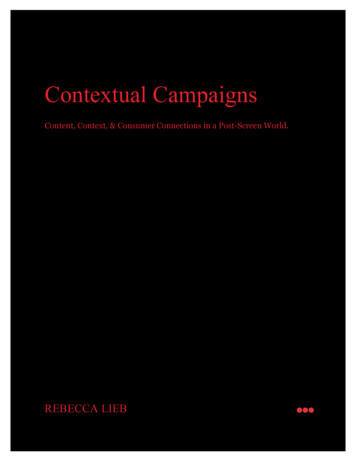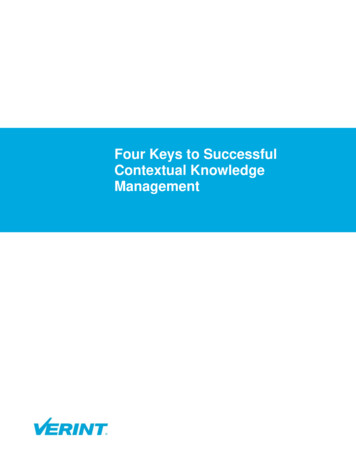
Transcription
Organizing CampaignsSummaryContextualfor ContentContent,toContext,ModelsIncorporate& ConsumerContent ConnectionsStrategya Post-ScreenWorld.Despitean overwhelmingtrendintowardcontentand Content Marketing in the Enterprise.marketing and the need to continually feed an everincreasing portfolio of content channels andformats, most organizations have not yet addressedcontent on either a strategic or tactical level. Thisreport explores scalable organizational models foraddressing content needs across the enterprise andmakes recommendations for a holistic program.This report is based upon 78 interviews withexecutives actively engaged in the evolution of contentstrategy and/or content marketing in theirorganizations. The qualitative interviews wereconducted with representatives from B2B and B2Ccompanies between October and December 2011 andJanuary and March 2013.REBECCA LIEBREBECCA LIEBOrganizing for Content1
Table of Contents03Executive Summary/Introduction04Defining Contextual Campaigns04Trends & Drivers of Contextual Campaigns07Contextual Marketing: The Rewards12Contextual Marketing: The Risks14Strategically Planning Contextual Campaigns19Best Practices & Recommendations22The Future22Methodology, Acknowledgements & Ecosystem Input24About the AuthorREBECCA LIEBOrganizing for Content2
Executive Summary/IntroductionThe good news? Marketers will soon be ableto hyper-target consumers, and reapunprecedented levels of data in the process.The bad news? It's about to getexponentially more complicated to do so.The right message to the right person at theright time. Digital marketing's originalpromise, once so bold and full of promise, isbeginning to seem quaintly outdated.Personalization is almost a given, and "righttime" is just one of a myriad of contextualfactors that can govern campaigns as well ascontent. Contextual marketing enables:The Right ServiceThe Right ProductThe Right PlatformThe Right PersonThe Right TimeThe Right PlaceMarketers are now empowered – and willvery soon be expected by consumers andtheir organizations alike - to deliver context,i.e. content that is finely honed by a myriadof hyper-relevant factors that take criticaland previously very disparate elements anddata into account. This enables new levels ofrelevance, for example: location, real time,conditions (e.g. weather, sales andpromotions, inventory, etc.), product orservice performance, product interaction, orpurchase and transaction history.The result is far-reaching value for brandsas well as their customers and prospects.Benefits and opportunities include greaterREBECCA LIEBreturn on investment (ROI), rich customerdata, and better customer experience.Context also can aid and facilitate lines ofbusiness beyond marketing, including (butnot limited to) customer service, supplychain/distribution, CRM, and productdevelopment, innovation, operations, evenfinance.For these reasons, contextual marketing willsoon enter a period of rapid growth andadoption. Consumers will very soon come toexpect contextual communications andexperiences, regardless of whether they arein a bricks-and-mortar location or using aconnected device. Brands must begin now torise to this challenge, adopting a test-andlearn approach to determine where thebenefits and value of contextual marketinglie, for their own businesses, theirecosystem partners, and the benefit of theircustomers and prospects.The untapped opportunity is migrating fromnoise to value; shifting marketing to aservice/utility function. "Push" becomesinvisible, while "pull" is solving aconsumer's immediate need.Additionally, contextual marketing offersextremely granular understanding ofcustomers, then anticipate their needs,wants, affinities, and expectations anddevelop unique insights to power bettermarketing across all devices, channels andlocalities.Digital content has moved beyond screens.It now infuses and surrounds objects, too.Content is more contextual, more mobile,more omnipresent. Consumers expect anOrganizing for Content3
ever-higher degree of relevant, personalizedand more highly contextual content. Thisexpectation will only rise as technologyevolves and brands become more adept atmeeting consumers along their journeysregardless of time, place or device.Contextual Campaigns: DefinitionContextual marketing provides content, experiencesand/or information that serve an immediate and circumstantially relevant purpose.It's "phygital," bridging digital and physical worlds. Its scope often goes beyond traditionalinterfaces, such as screens (see Fig 1, at left). Finally, the resultant data can inform and benefitbusiness functions beyond marketing, as well as ecosystem partners. Contextual marketing, inshort, opens a world of possibilities that don't existwith one-way marketing or advertising.Drivers & TrendsContextual marketing, as stated above, goes bothbeyond the screen and blasts far beyond "the rightmessage to the right person at the right time." Theprimary contextual drivers are:Digital Pervasiveness: This concept is sometimestermed "phygital," a portmanteau word for digital physical. You may roll your eyes, but buzzwords tendto emerge around new concepts. Contextual contentand experiences are what bridge physical and digital.The convergence of embedded sensors, networkedservices, mobile and cloud technology, often coinedas the Internet of Things (IoT), means that any ‘thing’can now simultaneously have a digital and physicallifecycle. From wearables like watches and clothes, toin-home appliances and entertainment systems, to[connected] cars, fobs, beacons, even in-storeinfrastructure, sensors and connectivity arepervading the physical world.REBECCA LIEBOrganizing for Content4
Example: Marantz's connected audio speakers enable the manufacturer tounderstand how its customers use the product. They know where the productresides, how often it's turned on and off, and what music is played from whichstreaming services. The company uses this data for proactive customer service, aswell as for cross- and upsell campaigns - to great effect. "We absolutely, 100% haveevidence that these targeted campaigns have a 5 to 7% purchase rate on all theemails we send. The email is so targeted that our open rates are 40 to 42%," saysScott Strickland, D M Group's global chief information officer.The Five Ws: Journalists have traditionally asked "Who, What, When, Where and Why?"Contextual demands the same, which is why "the right time" is only one component of potentialcontext in contextual messaging and campaigns. Saturday evening at 8:00 p.m. may be anindicator of free time, but the Where (cinema, bar, restaurant, airport, electronics store orhome) adds an enormous layer of additional context to temporal information for potentialmessaging. So do Number of Visits, Purchase History, Product Interaction, Proximity, Weather,News, and a host of other factors.Example: Disney resort guests receive a MagicBand, which functions as a park pass,credit card for concessions, room key, and more via thousands of sensors embeddedthroughout the park and hundreds of connected backend systems. Customer can begreeted by name at park attractions, shop, or order food at restaurants that "finds"them at their table. Another feature is, as Disney SVP Direct to Consumer GunjanBhow puts it, "Using my data in terms of line length, and capacity, to make my daymore magical, entertaining, delightful. If a customer is waiting on a particularly longline, based on the context of what have you done in your day, and how long differentlines are, we can present to you a preferable line with the notification: 'There's only atwo minute line at 'Alice in Wonderland.' We also get tremendous customerengagement, app downloads, and word-of-mouth."Product as Real-Time Brand Extension - Products and infrastructure become a real-timeextension of the brand. Through sensors/data and content, they provide brands with anopportunity to touch customers more often and more relevantly.Example: The MyQ garage door opener alerts users if they left their house open andvulnerable, and also sends garage door activity alerts so homeowners can trackcomings and goings. REBECCA LIEBContextual Campaigns5
Shift from cookie-based to individualtargeting: Cookie-based targeting has longbeen in decline1 due to the fact that cookiesare tied to devices rather than to individuals(and many of those individuals deletecookies). Targeting specific consumers,independent of device via CRM, loyalty,proximity or other data is an essentialelement of contextual marketing.Smartphone Adoption: Increasingly,consumers' smartphones are likely to haveWi-Fi, GPS, NFC, RFID, accelerometers,cameras, microphones, BLE, iBeacon, andother interactive features turned on, thelatter function estimated at 40% andgrowing2. These features are essential forenabling contextual marketing. Becausephones are all but expected to communicatewith wearables, gaming, home devices,within retail, and automobiles, youngerconsumers especially are entering analways-on mode in terms of these features3,making them reachable. A Mobile Firststrategy means leveraging the sensors inmobile hardware; smartphones are theremote control for everything.Infrastructure Adoption: Retailers andlocation-based businesses are rushing toembrace contextual technology such asembedded sensors, Beacons, geo-fencing,and wifi. Adoption of devices has, and willcontinue to surge4, with 6.2 millionproximity sensors in use in spring, 2016.Additionally, IoT, smart packaging andother devices are on a similar growth eting/mobile-beacons-grew-22-q4-2015/303655/ REBECCA LIEBContextual Campaigns6
Customer Journey/Customer Experience: Interest and attention to the customer journey,across channels and media, and throughout the purchase funnel, has spiked in recent years.According to Google Trends5, searches for the term have increased by a factor of 20 over the past12 years. Contextual marketing will soon be an essential tool for keeping track of customersacross devices, locations and purchase cycle.Decreasing Ad Effectiveness As traditional banner ads plummet in efficacy6, marketersremain continually challenged to reach consumers with messaging that's relevant, useful,persuasive, or that creates engagement, particularly on mobile platforms that lack the "realestate" for display advertising. Context is a powerful tool in the new marketing arsenal that is farless paid media-centric.The Integration Imperative: Context in marketing cannot exist without closely integratedsoftware systems. Disney's MagicBand relies on over 100 backend systems. That APIs are nowstandard with most software systems creates the ability to connect people, places and things.Systems, networks, security and devices are increasingly ore#q line%20Ads%20%20Final.pdf6 REBECCA LIEBContextual Campaigns7
Contextual Marketing: The RewardsContextual marketing is complex, requires significant upfront investment and a reimagining ofstrategy. Why bother? Marketers who test the waters quickly become committed for a myriad offactors, with ROI, higher sales and profitability topping the list of potential rewards tomarketers, as well as benefits that go well beyond sales and marketing to functions such as sales,service and retention. REBECCA LIEBContextual Campaigns8
Benefits for MarketersFinancialROI: Disney's Gunjan Bhow puts it bluntly: "The more context there is, the more ROI."Disney recouped the research and development costs of tying in video pre-ordercampaigns with geo-fenced in-theatre and in-store promotions (with partners includingFandango and Walmart) in less than six months with only three such promotions. Asmentioned earlier, Marantz is currently seeing a phenomenal 5-7% purchase rate onemail campaigns targeted by IoT data from speakers.Targeted MarketingCampaign & Sales Effectiveness: IoT products provide visibility into customer channelaffinity, leading to more effective media buys. Using deep customer data to understandwho buys and under what circumstances (e.g. sales-motivated, new features, etc.),enables manufacturers both to reduce inventory, lower write-offs, and not sell at hugediscounts. Because real time is a factor in most contextual campaigns, promotions caneasily be designed to craft special offer and/or service to move excess inventory, e.g. foodin a restaurant or empty theatre seats.Precise Targeting Integrating data sets such as CRM, purchase history, and psychoprofiles results in surgically precise targeting, enabling marketers to craft offers that arefar more compelling that those in broader-based initiatives.Communication Opportunities - Innovations such as smart packaging (e.g. NFCenabled) can provide information beyond the label at point-of-purchase such asfreshness or additional nutrition data. This can build trust and provide a nudge towardpurchase at the point of decision, of interest to major CPG brands such as Nestlé.Contextual campaigns can also monitor use or conditions to alert consumers when topurchase or service a product, and/or provide news, updates, or public awareness.Attribution: Because contextual campaigns are targeted to individuals who largely opt-into participate, attribution is much more transparent than in more traditional marketingchannels. This has a twofold effect: 1. Opt-in is user-driven (campaigns must, of course,provide value to users) and consent is actively obtained; 2. The real-time nature of suchcampaigns offers consumers context for understanding what they opt-in to.Loyalty By providing value, experiences, an opt-in relationship contextual campaigns canfoster loyalty or become critical drivers of existing customer loyalty programs. In effect,brands can leverage sensors and data integrations to reward consumers for theirbehaviors and interactions with the brand, product, in-store experience, etc. REBECCA LIEBContextual Campaigns9
Rewards & Incentives Direct and highly contextual messaging can spur purchase andreward users for their actions. Taco Bell has partnered with Waze, for example, toincentivize nearby drivers to make a late night purchase and receive a free dessert withtheir order. An iPhone app created by Dentsu in Japan allows shoppers to see animatedbutterflies flitting by. Each butterfly contains a coupon for a nearby business.Cool Factor: Both Hollister and MGM Resorts are looking to Snapchat as a brandinginitiative, serving relevant content when customers are near a physical location. "Is itmoving the needle?" asks Andy Kennemer of Abercrombie & Fitch, "It makes us cool andrelevant. We're doing because it feels right," adding the app is highly mobile, as well ashighly social for teens.Visibility and Buzz: Earned media: social, PR and word-of-mouth, are frequentbyproducts of contextual marketing initiatives. This halo effect will continue for the nexttwo years, while contextual campaigns continue to enjoy a novelty value. WhenUnilever's Maille Dijon mustard targeted foodie consumers in supermarkets withBeacons, the initiative garnered national media attention.Differentiation: In addition to sparking consumer engagement in lower-interestcategories (e.g. soft drinks, CPG), contextual marketing is a differentiator with partners,ranging from online to brick and mortar retail locations. Both manufacturers andretailers can, for example, benefit from joint campaigns as well as the resultant data.Data360 View of Customer: General location and hyper-local proximity are just twoexamples of a wealth of new customer data and customer journey information opened upby contextual marketing. DealerOn's Director of Search and Social Greg Gifford, forexample, intends to use Beacon data to learn which customers visit automobiledealerships for service versus those who might be interested in buying by tracking theirmovements inside the building. Additionally, some dealers are interested in targetingbrowsers, who visit the lot when the dealership is closed. Triangulated with data frompurchase history, Facebook and other social networks or the large ad networks, thisricher data feeds into a wealth of potential messaging and CRM initiatives.Deeper Customer Data: When provided with information and experiences that arevaluable, useful, fun or interesting, consumers will, in exchange, volunteer more dataand information. In fact, the more device consumers own, the more interested they arein engaging with brands about the use of their data.7Context Beyond Third-Party Data: Ultimately, brands may need to invest less in thirdparty data and targeting once highly contextual data streams are established. -of-things/ REBECCA LIEBContextual Campaigns10
deeper, proprietary data can in some cases itself be productized (see below under NewRevenue Streams").Benefits for the OrganizationOperational Insights and Decision-Making: How customers interact with brands before, during,and after their purchase experiences carries insights far beyond marketing. Many brands areimplementing in-store technologies, for example, not to immediately engage shoppers, butinstead taking initial steps towards tracking store traffic, layout, and inventory. While footpatterns can be used for marketing optimization, brands are also (often initially to ‘test thewaters’ of such new technology) using this data for back-end operational decision-makinginvolving stock, labor allocations, in-store layout, energy efficiencies, employeecommunications, governance, etc.Product Development & Innovation: Contextual information from campaigns and devices feedsback into R&D and helps to maximize investment. Manufacturers can retire features they knowcustomers aren't using, and develop new products targeted to who their customers are and howproducts are used. D M noticed, for example, a large number of customers named their audiogear "Bathroom" so they developed a waterproof line to market to those consumers, whichquickly sold out. A more rugged line of products is currently in development for customers whoname their set up "Garage."Supply Chain Visibility & Insight: Contextual marketing, sensors, and IoT functionalityprovides visibility into how products are used, shines new light on the supply chain anddistribution. Nestlé hopes, for example, to soon only dispatch its delivery fleet to stock freezersthat are empty, bypassing retailers not short on inventory. And, as one manufacturer put it, "ifyou know where products are you can recall them if necessary." Smart packaging on CPGproducts, while potentially providing unique social media tie-ins or access to exclusive contentfor consumers, also offers manufacturers insights about patterns and integrity of thedistribution and/or retail lifecycle.New Revenue Streams: Manufacturers that embed connectivity capabilities into products areamassing significant data about how consumers use and interact with those devices, as well asthe services they connect to those devices. "IT could become a profit center," notes oneexecutive, "we are considering selling this data back to streaming media services, for example, sothey can directly see how they stack up against their competitors." Partnerships acrossdistributors, manufacturers, vendors, retailers, telecom, insurance, and a diverse array of otherservice providers also introduce new business model opportunities through connected productdata. REBECCA LIEBContextual Campaigns11
Benefits for ConsumersImproved Experience Contextual experiences can surprise, delight, assist, inform and entertainconsumers, leading in turn to increased loyalty, word-of-mouth, and brand favorability.Customer Service Implanted IoT technology allows manufacturers to proactively offer customerservice when, for example, a device has been re-started numerous times within a specifictimeframe, indicating the consumer may be having issues or requires assistance. Theopportunity is both enhancing reactive support as well as enabling proactive (and eventuallypredictive) support.Product Service: Smart devices can "phone home" to automatically upgrade or, for example,order supplies. A printer might be connected to Amazon or Staples to automatically replenish itsink. The ability for products (like Amazon's Echo) to not only serve as platforms for content andservices, but increase in functionality, personalization, and value over time through softwareupdates is a disruptive customer relationship model.Humanistic/Altruistic: Contextual marketing can not only spur or assist in purchases,conversions and transactions, but also genuinely help consumers by, for example, monitoringtheir health and making suggestions for care or remedies for underserved populations like theelderly or blind.Contextual Marketing: The RisksAs with any new form of marketing and emerging marketing technology, contextual campaignsbring risks together with benefits. While risks can be mitigated with best practices, which arealso still emerging, it's important they be carefully considered by brands embarking intocontextual campaigns and messaging.Below, the primary risks marketers say they are encountering.Creepiness Deep visibility into what consumers are doing, where they are when, and whatthings they're using or interacting with can shock, jar, and otherwise come across as BigBrotherish when contextual communications are read as over-personalized. REBECCA LIEBContextual Campaigns12
Alienating users False positives, bad data and incorrectly configured campaigns can result inundesired effects. A nearby consumer who hates a brand might be targeted with a message fromthat brand. Poor profiling can damage brand credibility.Differing privacy and data laws Brands operating on a global scale must often tailorcontextual campaigns regionally due to differing laws and regulations around data, privacy anddata sharing with partners. Upcoming regulations such as the Global Data Protection Regulation(GDPR) could fundamentally alter how organizations can collect, store, and analyze customerdata in specific countries. Mandates such as this will have a direct impact on businesses’requirements around obtaining consent, profiling, data protection, cyber-security, certifications,etc. Cultural variations and sensitivities will also be a consideration.Opt-in and permission requirements To operate at scale, brands will be challenged toeffectively communicate value to consumers, otherwise they'll risk being shut out or ignored.Bad data Brands must keep multiple data sources current to maintain and insure context.When a retail location moves, for example, incorrect location data may be the result.Investment: Contextual marketing can still be expensive, not only in terms of data andenterprise technology investments, but also deployment on a mass scale. "Thin film [packaging]applications create new opportunities to engage at point-of-purchase," notes Nestlé's MarkBrodeur, global head of digital marketing innovation. "But currently the cost is still out of reachat scale as we sell approximately 1.2 billion units per day around the globe."Customer adoption & scale: Highly dependent on category, for some brands, such asclothing retailers where an average customer shops only three or four times annually it can bedifficult to justify investment. Another aspect is how many customers will be detectable in theenvironment via Bluetooth, Wi-Fi, or shared location,Inevitable Tragedy of the Commons All new forms of digital marketing technology havebrought with their benefits the potential for abuse, exploitation and malpractice. Irresponsibleand unethical marketers will inevitably tar contextual marketing with that brush, arousingconsumer suspicion and potential regulatory attention.Attribution: While contextual campaign attribution exceeds that of more traditionaladvertising, multi-touch attribution is still not mature and can be a stumbling block. Connectthis back to the need for systems and device interoperability. Otherwise we’re just creating moresilos. This also calls forth integration across “domains”-- home, car, work, in-store, etc.Culture and teams: Establishing and scaling teams, marrying marketing and technology,education, standards and measurement remain uncharted territory in many organizations.Lack of content strategy: The preponderance of brands still lack a formalized, documentedcontent strategy. Overwhelmingly, mindsets remain both campaign and product-centric.Contextual campaigns require a wealth of content that's contextually and channel relevant, REBECCA LIEBContextual Campaigns13
personalized but not creepy, and in numerous versions that address multiple scenarios (time,locations, conditions, device, etc.).“Content is a big problem for many brands. We are focused on capturing andsharing authentic content from our target customer that intersects nicely with thefuture direction of the brand.” –Andy Kennemer, VP Omnichannel Marketing, Abercrombie & FitchInteroperability & Integration: Walled-garden media channels and a lack of fully integratedback end systems that seamlessly integrate CRM, data, creative, advertising, creative, socialmedia and a host of other marketing and enterprise functions limit campaign efficacy, as well asmarketers' view of the individuals interacting with the campaign.Novelty factor As with other emerging technologies that were once marketing darlings,campaign efficacy may fall off after the initial novel effect, dampening marketers' faith andenthusiasm. The utility and real value creation (vs. noise) of such campaigns becomes central totheir viability and reception.Strategically Planning Contextual CampaignsOverwhelmingly, marketers committed to contextual campaigns extol the rewards and potentialof the practice, while at the same time emphasizing the complexities of the inherentconsiderations. Following, the primary considerations marketers must consider before investingin context.What Comes First: Technology, Data or the Consumer?The primary differentiator in approach to contextual marketing seems to be the chicken-and-eggquestion of what drives campaigns: technology innovation, the customer journey, or data.Marketer approaches at this point seem to largely rest of the size and diversity of the business.Smaller, more vertically driven businesses are more likely to say "it also rest completely on thetechnology," the approach of DealerOn's Greg Gifford.Other marketers cite specific vision and the ability to solve problems or optimize performance asan impetus. Triangulating first, third and partner data to target in-store coupons and maponline/offline conversion is one example. One retailer (who asks not to be identified) found theSKUs selling on the company's app weren't moving in physical stores. This sales and behavioraldata led to a change the physical merchandising strategy. Yext CMO Jeffrey Rohrs emphasizes REBECCA LIEBContextual Campaigns14
that you must first define the outcome you're seeking before you can map the "story" that willlead customers through content and technology.The largest, most diversified enterprises view tech as "table stakes," as GE's Andrew Markowitzputs it, looking instead at a broader vision corporate vision, "Tech makes all things possible, butit doesn't necessarily make them easier," he notes. Nestlé's approach is similar, consideringbrand DNA and "why are we in business," before technology, the latter of which Mark Brodeurcalls "an enabler."The most mature companies will lead strategy with customer journey and experience, as well asa value exchange between brand and customer. Technology and data support that vision and itsexecution.Partners & EcosystemInternal PartnershipsContextual campaigns require significant integration of disparate technologies, data sources,and partnerships among stakeholders. Internal alignment is critical at the enterprise levelbetween, for example, marketing and IT, as well as among any functions embracing CRM anddata. Legal must also have a seat at the table where data and privacy are concerned. Similarly,MGM Resort’s Beverly Jackson also cites security’s role in campaigns tied to physical locations.Operations can help keep locations data current.External PartnershipsContextual campaigns also require rethinking external partnerships. For manufacturers, thiscan necessitate finding retail partners willing to experiment with in-store technologies such asBeacons and sensors, with both parties sharing responsibility, investment, insights and data.Disney looks to partnerships with cinema chains and online partners such as Fandango andYouTube in order to target customers when they are seeing a film. The customer journeybreadcrumb trail of where and what a customer has clicked on reveals more useful data,according to Disney's Bhow, than a customer's interaction directly with the brand or itsproducts. "The big revelation is that your journey as a person is far more useful for us than eventhe Disney journey you took."Market information and data services from NPD Group, Nielsen, JD Power and similarsuppliers, as well as point-of-sale data are also frequently critical to shape and inform contextualcampaigns.When context and intelligence in the form of technology are embedded into objects, thesepartnerships extend to technology providers, design, and manufacturers. REBECCA LIEBContextual Campaigns15
While agencies don't yet figure prominently in the partnership equation for contextualcampaigns, or when they do, it's likely to be the consultancies now competing in the agencyspace, e.g. Accenture and Deloitte. As one brand executive put it, "These initia
business functions beyond marketing, as well as ecosystem partners. Contextual marketing, in short, opens a world of possibilities that don't exist with one-way marketing or advertising. Drivers & Trends Contextual marketing, as stated above, goes both beyond the screen and blasts far beyond "the right message to the right person at the right .










